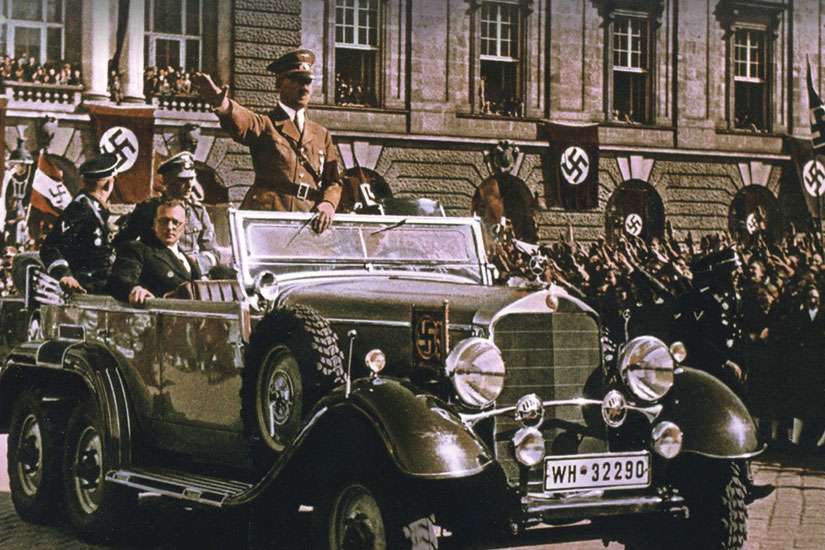Brown-Fleming was in Toronto for Holocaust Education Week as one of two American Catholic scholars looking at how Catholics dealt with Nazi ideology and how they failed to condemn the persecution of Jews. Fr. Kevin Spicer lectured on how ordinary Catholic priests worked with and under Hitler’s racist, fascist regime.
The particular history Brown-Fleming researches is the transition from a Church ban on Catholic membership in the National Socialist Party in 1931 to German bishops allowing Catholics to become Nazi party members — which paved the way for the Church to negotiate a concordat with Berlin in 1933.
The Vatican and the German bishops had condemned the Nazis in 1930 and banned Catholic membership in the party in 1931. Then in March 1933, Hitler promised to deal honourably with the churches, respecting their autonomy.
“So the political calculation the German bishops made was, ‘OK, we’re going to take him at his word. He’s going to honour Catholic life in Germany, so we’re going to lift the ban (on Nazi party membership),’ ” said Fleming-Brown.
The Vatican’s nuncio to Germany, Eugenio Pacelli (who would later become Pope Pius XII), took the stance that German bishops knew best how to deal with their own government. But as soon as the bishops agreed to play ball with Hitler, an “Aryan Paragraph” was inserted into all German laws, ensuring that only Aryans could be employed in any organ of the state.
Jewish leaders came to the Catholic bishops and asked for their help in fighting the new legal regime.
“The German bishops had internal discussions and decided it’s too fraught a time for Catholics, who are also at risk, to step outside the box for Jews,” said Fleming-Brown. “In essence, the Church made a decision in April 1933 to protect their own institution and their own interests, rather than say something on behalf of Jewish colleagues… A few Catholics at the time really became outraged and incensed about this and wrote in to the Holy See and their bishops saying, ‘If the Catholic Church doesn’t stand up now its reputation will suffer in the future, and we will be next, and this is a big mistake.’ ”
But the bishops had decided.
“The Church as a whole never did accept the racial policy, though it never did clearly condemn the treatment of Jews,” said Spicer. “We need to understand that history so we can talk about it in an intelligent way. Is it something to repent for? Clearly the Church never spoke out in a very public statement against the persecution, deportation and murder of Jews within Germany.
“What we don’t know is, what did the ordinary priest do? How did the ordinary priest respond to the state? How did ordinary Catholics see the world at that time?” he asks.
Spicer's research covers the role of Christian anti-Semitism in building support for Nazi ideology.
While some clergy were attracted to the idea of a disciplined and united Germany — purged of vice and purified of outside influences — ordinary Catholics were not so enamoured.
“Across the board, votes of Catholics for National Socialism were much lower than for Protestants,” said Spicer.
But the Great Depression and anger Germans felt over their treatment at the hands of the Allies after the First World War were Hitler’s trump cards.
“After ’33, there was an openness among all Germans to things that Hitler was talking about, to promises he was making economically,” said Spicer.
Getting at the social psychology that supported the Nazis isn’t just an interesting historical conundrum for Brown-Fleming.
“I myself, am partially German — born of a German mother — and a practising Catholic,” she said. “So, for me, it’s not a history that’s a distant history. For me, it’s part of my family history.”
Brown-Fleming is a director of visiting scholar programs at the U.S. Holocaust Memorial Museum in Washington. She has to reconcile her experience of Catholicism as a force for good and tolerance with the 2,000-year history of Christian anti-Semitism.
“Where I started — and I think it’s a question for all Catholics because of the 2,000-year history of Christian anti-Semitism — emotionally and intellectually is that I couldn’t understand how a Church that taught and I knew to teach an ethic of reciprocity, and love, and mercy, and love of neighbour could have been so implicated in this history,” she said.
No matter what answers we come up with, the questions will always be with us.


